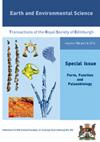Paralonchothrix gen.nov.,Echimyini(啮齿目,八齿目)在南美洲中新世晚期的第一个记录
IF 0.9
4区 地球科学
Q4 GEOSCIENCES, MULTIDISCIPLINARY
Earth and Environmental Science Transactions of the Royal Society of Edinburgh
Pub Date : 2021-06-01
DOI:10.1017/S175569102100027X
引用次数: 2
摘要
摘要棘鼠科是三颌目啮齿类动物中种类最多、生活方式多样的一科。在南美洲南部的巴塔哥尼亚次区域,与现存的树栖物种(Echimyini)有关的已灭绝针虫被记录到中新世中期,而自中新世晚期以来所有已知的南部化石都与目前居住在南美洲东部Chacoan开放生物群落的陆地和化石谱系有关。在这项工作中,我们描述了阿根廷西北部和巴西西部中新世晚期的一个新的针虫啮齿动物属,Paralonchothrix gen.nov。其唯一被认可的物种,黄腹副龙舌兰。nov.,由两个半下颌表示。其中一个来自Loma de Las Tapias组的一个层面,位于7.0±0.9 Ma的凝灰岩之下(华奎时代,中新世晚期);另一个标本来自Santa María山谷的“Araucanense”(模式位置,华克时代,中新世晚期)。系统发育分析将Paralonchothrix与Lonchotrix联系起来,两者都是Mesomys的姐妹群。因此,在南美洲南部的中新世晚期,首次发现了一种与亚马逊树栖分支有关的针虫。因此,Paralonchothrix gen.nov.代表了一个特殊的记录,这提出了审查自中新世晚期以来在高纬度记录的针虫类假设进化模式的必要性。这个新属提供了Mesomys和Lonchothrix之间分歧的化石记录中的最小年龄(约7 Ma)。阿根廷西部和西北部中新世晚期推断的古环境条件表明,该地区属于稀树草原型环境,安第斯山脉附近的山谷中有更多的封闭林地。Paralonchothrix gen.nov.的记录支持了这样一种假设,即该地区在中新世晚期与南美洲北部的热带生物群落保持着联系。本文章由计算机程序翻译,如有差异,请以英文原文为准。
Paralonchothrix gen. nov., the first record of Echimyini (Rodentia, Octodontoidea) in the late Miocene of Southern South America
ABSTRACT Echimyidae is the most widely diversified family among hystricognath rodents, both in the number of species and variety of lifestyles. In the Patagonian Subregion of southern South America, extinct echimyids related to living arboreal species (Echimyini) are recorded up to the middle Miocene, whereas all the known southern fossils since the late Miocene are linked to terrestrial and fossorial lineages currently inhabiting the Chacoan open biome in eastern South America. In this work, we describe a new genus of echimyid rodent, Paralonchothrix gen. nov., from the late Miocene of northwestern Argentina and western Brazil. Its single recognised species, Paralonchothrix ponderosus comb. nov., is represented by two hemimandibles. One of them comes from a level of Loma de Las Tapias Formation, underlying a tuff dated at 7.0 ± 0.9 Ma (Huayquerian age, late Miocene); the other specimen comes from the ‘Araucanense’ of Valle de Santa María (type locality, Huayquerian age, late Miocene). A phylogenetic analysis linked Paralonchothrix to Lonchothrix, both being the sister group to Mesomys. Thereby, for the first time, an echimyid linked to living Amazonian arboreal clades is recognised for the late Miocene of southern South America. Paralonchothrix gen. nov. thus represents an exceptional record that raises the need to review the postulated evolutionary pattern for echimyids recorded at high latitudes since the late Miocene. The new genus provides a minimum age (ca.7 Ma) in the fossil record for the divergence between Mesomys and Lonchothrix. The palaeoenvironmental conditions inferred for the late Miocene in western and northwestern Argentina suggest savanna-type environments, with areas with more closed woodlands in peri-Andean valleys. The record of Paralonchothrix gen. nov. supports the hypothesis that this area would have maintained connections with tropical biomes of northern South America during the late Miocene.
求助全文
通过发布文献求助,成功后即可免费获取论文全文。
去求助
来源期刊
CiteScore
2.00
自引率
0.00%
发文量
21
期刊介绍:
Earth and Environmental Science Transactions (formerly Transactions of the Royal Society of Edinburgh: Earth Sciences) is a general earth sciences journal publishing a comprehensive selection of substantial peer-reviewed research papers, reviews and short communications of international standard across the broad spectrum of the Earth and its surface environments. The journal prides itself on the quality of its graphics and photographic reproduction. The Editors are keen to encourage interdisciplinary papers and Transactions also publishes occasional special symposia and invited volumes of specific interest.
We are currently in the process of digitising the archive of RSE Publications, and the archive of the Transactions, dating back to 1788, will be available from the back issues link on this site.

 求助内容:
求助内容: 应助结果提醒方式:
应助结果提醒方式:


